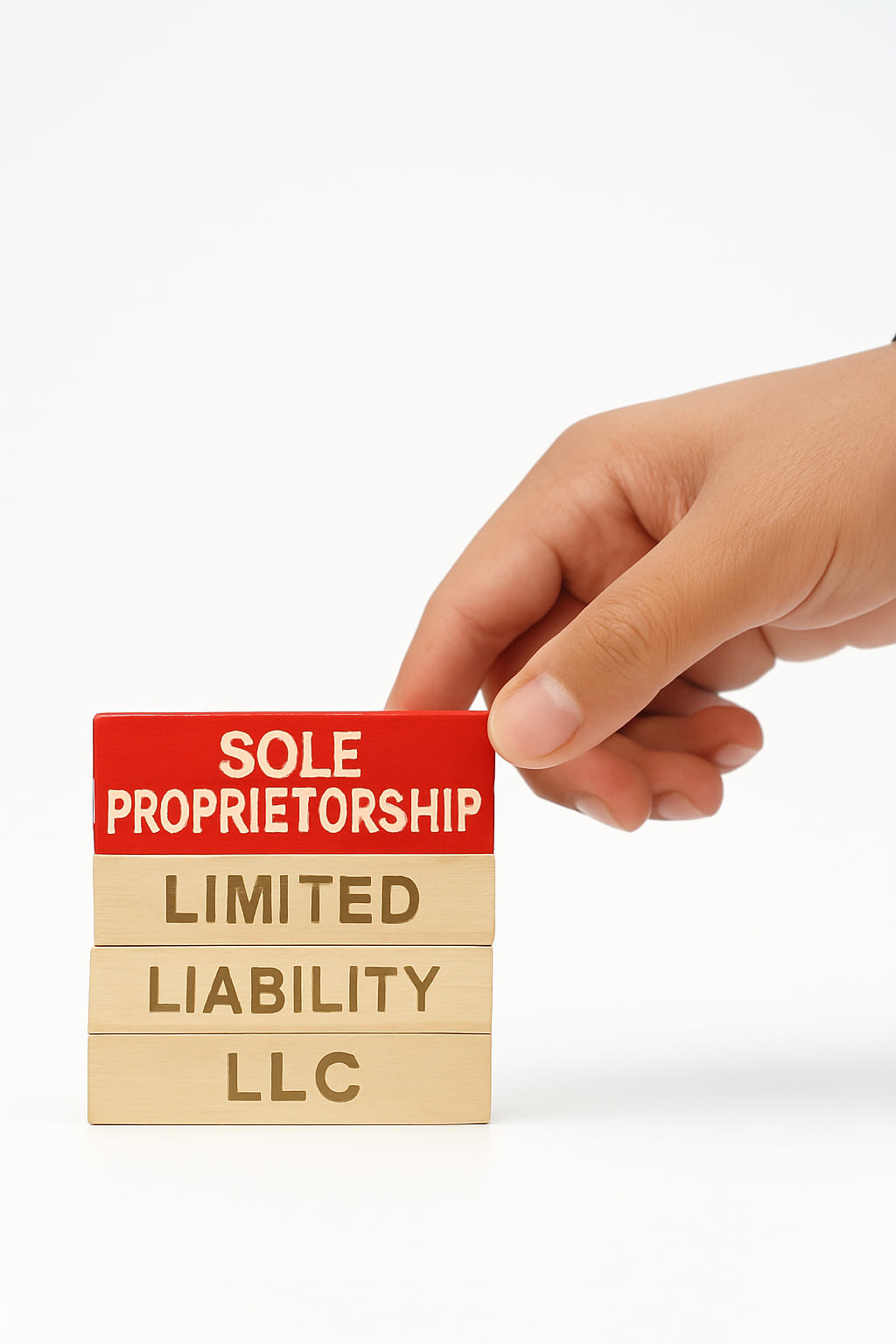Choosing the Right Legal Entity for Your Startup - Exploring Sole Proprietorships
- Choosing the Right Legal Entity for Your Startup - Exploring Sole Proprietorships
- What Are the Best Types of Businesses to Operate as Sole Proprietorships?
- Who Is Eligible to Operate as a Sole Proprietorship in the US?
- How to Register a Sole Proprietorship?
- What Are the Key Advantages of Sole Proprietorship?
- What Are the Key Disadvantages of Sole Proprietorship?
- Sole Proprietorship vs. Sole Proprietorship vs. LLC vs. Corporation
- How is a Sole Proprietorship Taxed?
- Pros and Cons of Sole Proprietorship Taxation
- How to Convert a Sole Proprietorship?

When starting a new business, one of the most crucial decisions you have to make is what type of legal entity to become. One option is a sole proprietorship. All sole proprietorships are small businesses, but not all small businesses are sole proprietorships. Even if you work alone, you could set up an LLC or corporation instead. Depending on the type of company and the work you do, choose a legal entity that benefits you in the long run, not just for today.
Sole proprietorships are the simplest form of small business entities. Roughly 73% of all small businesses are registered as sole proprietorships. According to U.S. Census Bureau data, there are roughly 830,000 sole proprietorships in the U.S., encompassing 10.24% of all businesses.
Before putting out your shingle and opening up shop, you need to think strategically about your future and how your business structure represents you. Consider how a sole proprietorship differs from an LLC, S or C corporation, and a partnership. Focus on the needs of your business and what is best for your situation. If you are an entrepreneur or freelancer just starting out, a sole proprietorship is an easy and cost-effective option to get up and running quickly without the legal hassles, costs, and paperwork associated with other forms of business.
What is a Sole Proprietorship?
A sole proprietorship is the most common legal structure for small businesses. In this type of business entity, one person owns all the assets and assumes liability for all the debts. There is no distinction between the business and the owner; they are legally one entity. The business may be referred to as a proprietorship, and the owner is the sole proprietor.
The sole proprietor has complete control over the business and makes all decisions themself. The owner is entitled to all the profits and is also personally responsible for all liabilities, debts, and losses the business incurs. Forming a sole proprietorship is quick and straightforward without any formalities. The business is not required to file a separate income tax return; all income, expenses, profits, and losses are reported on the sole proprietor’s tax return. The owner does not have to formally register a sole proprietorship with the state as with other forms of legal entity.
Key Features of Sole Proprietorship
Many consultants, contractors, and small business owners will find that sole proprietorship works best for them. Some of the features of a sole proprietorship include:
What Are the Best Types of Businesses to Operate as Sole Proprietorships?

Sole proprietorships work best for businesses that require low startup costs, are legally low-risk, and have straightforward operations. These businesses usually have one person doing all the work with no additional employees. The owner manages it independently without any input from others. Some of the most suitable types of businesses that will choose to operate as a sole proprietorship include:
- Freelance and Consulting Businesses:
Freelancers make up a large section of American business professionals. These professionals work as consultants for clients who pay them and then issue a 1099 at tax time. Some examples include writers, marketers, web developers, accountants, legal personnel, architects, engineers, and computer and IT service specialists.
- Transportation/Warehousing/Storage:
The transportation, warehousing, and storage industry is full of sole proprietorships. Truckers, taxi drivers, bus drivers, limousine drivers, and car-sharing service workers all fall under this category. Some others include messengers, couriers, towing companies, and those who rent out warehouses or storage space.
- Home-Based Business:
Many people successfully operate a home-based business and don’t need anything beyond that. Some examples include virtual assistants, e-commerce stores, drop-shipping services, and handmade product sales.
- Service Business:
Service-based businesses provide necessary services rather than products. These people often operate as sole proprietorships. Some include personal trainers, tutors, house cleaners, landscapers, in-home caregivers, and event planners.
- Independent Contractors:
Independent contractors also choose to operate as sole proprietors. Some examples include delivery services (food/packages), real estate, software engineering, house cleaners, tax preparers, sales representatives, or business consultants.
- Retail & Small Shops:
Small retail shops and online resellers may also become sole proprietors to keep things simple. Some occupations in this line of work include farmers’ market vendors, boutique shop owners, mall kiosk owners, food truck businesses, bakeries, online subscription services, bookstores, ice cream stands, and a specialty health food store.
- Skilled Trades:
People specializing in skilled trades also like keeping their businesses simple. Some who fall into this category are electricians, plumbers, landscapers, handymen, seamstresses, automotive mechanics, ironworkers, welders, HVAC technicians, masons, house painters, cooks, hairstylists, carpenters, and other types of solo tradespeople.
- Photography & Videography:
Business owners who offer photography and videography services are widely sought after. They may specialize in wedding photography, commercial photography, or portrait services. A sole proprietorship works well for these businesses.
- Pet Services:
Those who love animals may choose to embrace a dog-walking, pet-sitting, or grooming career and will not need anything more than a sole proprietorship to get up and running.
- Food and Catering Services:
Small-scale catering businesses, personal chefs, and home bakers (subject to local food regulations) may also choose a simplified business structure and become sole proprietors.
- Coaching & Instruction:
Coaches choose personal instruction to positively impact people’s lives and pass along their extensive knowledge in a specific area. These professionals include business coaches, life coaches, fitness trainers, and music instructors.
- Consultants/Speakers:
Professional speakers may operate a sole proprietorship under which they can bill for their speaking engagements and seminars.
Sole proprietorships work best for individuals who prefer simple business structures with full control over operations and decision-making. However, since personal liability is not separated from the business, entrepreneurs in high-risk industries may want to consider an LLC or another legal structure for added protection.
Who Is Eligible to Operate as a Sole Proprietorship in the US?
Before deciding to become a sole proprietor, you must ensure that you are qualified. If you own an unincorporated business, you can become a sole proprietor. However, your business must comply with the key points below before you can choose this form of business structure.
- One Person:
A one-person business is entitled to become a sole proprietor, but a company with multiple owners cannot.
- U.S. Work Permit:
You must have a valid U.S. work permit or be a native U.S. citizen.
- Valid Licenses:
You must obtain any federal and state licenses that pertain to your business before establishing your sole proprietorship.
Your choice of business entity is critical to your business. It defines the structure, dictates the types of reports you must submit, and impacts your taxes.
How to Register a Sole Proprietorship?
Registering your business as a sole proprietorship provides you with a solid foundation upon which to grow. The business of registering your company as a sole proprietorship in the U.S. is typically quite simple. Follow the steps below to get started:

The first step is to choose a name for your business. Pick something simple yet impactful and says something about your business or what you do. Don’t choose a name that is too long, confusing, or hard to spell. You want to make it easy for your customers to find you. Use your state’s Secretary of State website, commercial division to see if the name is available. No two businesses can have the same name within the state. You should also check with the trademarks database to be sure the name is not taken. Use a domain service to see if you can register your company name as a domain. You may have to get creative if the domain you want has already been taken. Check on social media to see if you can use the name there also for promotion.
You can run the business using your name or a DBA (doing business as). Some states will require you to register a DBA if you pick a name that does not match yours. If you already have a strong client following and a good reputation under your own name, use your name as the business name.
Many types of businesses require permits or licensing before you can begin operations. Local, state, and federal agencies issue these licenses and regulate how and when you need to renew them. To operate as a sole proprietor, you must obtain all the necessary licensing for your occupation. Contact your county clerk to find out what type of licenses you need before opening your doors. If you run a business that deals with meat, alcohol, firearms, or tobacco, you will need a license to sell these items.
Registering with the local tax authority is another step you must take before establishing your sole proprietorship. Contact the state office regulating your business type and register your company. For example, if you sell retail goods, you may have to pay and submit sales tax.
If you think you may ever hire employees to work for you, you will need a federal Employee Identification Number (EIN) from the Internal Revenue Service. You can apply for one directly on the IRS website. Most banks will require you to have one to open up a business bank account.
Although you can use your own bank account, most experts will advise you to open one specifically for the business to keep things organized. At tax time, it will be easier to see precisely what your income and expenses are if you have a dedicated business account. Visit your local bank and apply for a new account under your business name. Bring your EIN with you.
What Are the Key Advantages of Sole Proprietorship?
As with anything, there are advantages and disadvantages to a sole proprietorship. Let’s begin with the key benefits you will enjoy by structuring your business as a sole proprietorship.
What Are the Key Disadvantages of Sole Proprietorship?
From the list above, you can see quite a few good reasons to structure your business as a sole proprietorship. However, as good as those things sound, you should also be aware of some disadvantages of becoming a sole proprietor. Some key drawbacks include:
Sole Proprietorship vs. Proprietorship vs. LLC
As you explore the possibility of a sole proprietorship, you must also compare how it stacks up against a partnership or LLC. A sole proprietorship is an individual owner, whereas a partnership is when two or more people own the company. An LLC can also be a single owner or multiple people.
A sole proprietorship leaves you vulnerable regarding liability, but an LLC separates you from the business assets and shields you from personal loss. With a partnership, each owner has limited personal liability as long as they do not participate in management (this varies based on the type of partnership). Sole proprietorships and partnerships have very few legal requirements, but LLCs require more, such as annual meetings and reporting.
The table below shows more detail comparing all three entities side-by-side.
| Characteristic | Sole Proprietorship | Sole Proprietorship | LLC | S-Corp | Corporation |
|---|---|---|---|---|---|
| Formation | Quick and simple with no filing requirements with any government agency. | Simple to create with no legal filing requirements. | More expensive to create and requires filing with the state. | An S-Corp is more costly to establish, and it requires state filing. | It is more expensive to establish and requires filing with the state. |
| Cost of Formation | None | None | The cost of the state filing fee is usually between $100-$150. | The cost of registering an S-Corp with the state can be anywhere between $20 and $800. | The average cost to register a C-Corp in the United States is $633. |
| Business Name | Can operate under the owner’s name, or a fictitious name using a DBA. | Can operate under the owner’s name, or a fictitious name using a DBA. | Must register an official company name with the state that is established and secured. | Must register an official company name with the state that is established and secured. | Must register an official company name with the state that is established and secured. |
| Taxation | Pass-through taxation, where all everything is filed under the owner’s personal taxes. | Filed under the partnership. Each partner claims their income and losses on their personal returns based on their percentage of the business. | Pass-through taxation, where everything is filed under the owner’s personal taxes. If there are multiple owners, taxation is treated like a partnership. | Each owner declares their share of profits/losses on their personal returns. Income is allocated based on owner percentage. Owners can use corporate losses to offset other types of income. Fringe benefits are limited to owners who own more than 2% of the shares. | The C-Corp is a separate taxable entity that must file returns. Owners split profits and only declare their portion on personal income tax returns. Owners can deduct fringe benefits as business expenses. |
| Liability | The owner is personally liable for all business actions, liabilities, debts, and damages. | Owners are personally liable for all business debts. | Business is its own entity; therefore, the owner(s) are protected against personal liability. | Owners have limited liability for personal debts, and business legal issues. | Owners have limited liability for personal debts and business legal issues. |
| Operational Requirements | No operational requirements are necessary. | No operational requirements are necessary. | More formal requirements than an LLC but not as strict as a C-Corp. | Much easier to maintain than a corporation. Annual member meetings and a report are required. | Annual meetings are required, and members must vote on changes. Shares of stock must be sold to raise capital. |
| Management | Full control of all decisions, management, and operations. | Each partner has equal control and decision-making ability. | An operating agreement outlines how each member can manage the company. | Managed by a group of directors that shareholders vote in. | Managed by a group of directors that shareholders vote in. |
| Raising Capital | Can be challenging and the owner often must invest his/her own money. | Each partner can invest, and more partners can be added to raise additional capital. | Managers can sell interest in the business to raise capital based on operating agreement restrictions. | Can sell shares of stock to raise capital. | Can sell shares of stock to raise capital. |
| Transferability of Interest | No | No | Possible based on the operating agreement restrictions. | Yes, as long as IRS regulations about who can own stock are honored. | Shares of stock can be easily transferred. |
How is a Sole Proprietorship Taxed?

The main difference between sole proprietorships and other legal business entities is how they are taxed. Sole proprietorships work based on pass-through taxation, meaning the owner must report all business income and expenses on their own tax returns.
Along with their 1040 form, the sole proprietor will include a Schedule C detailing the business’ income, expenses, and resulting profit/loss. Sole proprietors must also file a Schedule SE with their taxes and pay self-employment taxes (Social Security and Medicare) when they file their return. With other business types, the business is considered its own entity and must file its own tax return. At the same time, the owners/managers only claim a portion of the profit/loss or income they received from the business.
Sole proprietorships allow some special deductions that may not apply to other business entities. These are as follows:
- Health Insurance Deduction:
You may deduct the cost of your health insurance premiums for you and your family on your tax return.
- Business Vehicle Usage and Mileage:
You can also deduct mileage and vehicle usage based on the IRS rules. Check them carefully before deducting.
- Self-Employment Tax:
When you own a sole proprietorship, you are responsible for paying 100% of Social Security and Medicare taxes, but you get to deduct 50% of that as an expense on your taxes.
- Home Office Deduction:
When you have a home-based business, you can claim the Home Office Deduction, which is a portion of your home expenses based on the size of your home office.
- Banking and Insurance Fees:
A sole proprietorship allows you to deduct insurance and bank fees on your tax return.
- Professional Development:
You can also deduct the cost of taking classes directly related to your profession.
- Business Meals:
If you regularly take clients out for a meal and discuss business, you can deduct those expenses from your taxes.
- Traditional IRA Contributions:
If some of your income goes into a traditional IRA, you can also take that deduction.
- Phone and Internet Services:
With a sole proprietorship, you can deduct anything that supports your business, like internet and phone, which you need to conduct operations.
- Professional Services:
If you pay a lawyer or accountant to prepare your taxes or help you with a legal issue, you can deduct those fees as an expense from your taxes.
Pros and Cons of Sole Proprietorship Taxation
The other supporting form you will file is a Schedule SE for self-employment taxes. You must pay self-employment taxes if you have a profit of $400 or more in a year. However, you can claim 50% of those as a deduction. The remainder gets carried over to your 1040 and added into the rest for filing.
Use this table below from the IRS to be sure you are filing the correct forms:
Pass-through taxation is good and bad. It simplifies your tax return, and there can be no confusion; you must declare everything the business made. However, it can raise your personal income tax rate significantly and cause you higher taxes.
How to Convert a Sole Proprietorship?
You never know what the future holds. If your business takes off or changes, you may be inclined to modify your business type to align with your future business goals. Many people start out as a sole proprietorship or partnership and switch to an LLC later. Some of the reasons you may want to convert a sole proprietorship to another business entity are:
- Taking on Bigger Clients:
If you are gaining a lot more business and taking on important clients, it might be time to increase your credibility by switching your business entity.
- Seek Financing:
If you need financing to grow the business, you may want investors, but they are more likely to provide the funding to an LLC or corporation than a sole proprietorship.
- Limited Liability:
A sole proprietorship offers you no personal liability protection, but an LLC or corporation does. It might be time to protect yourself as your business grows, and so does risk.
- Larger Employee Pool:
The more employees you have, the more risk you face. Adding more staff members to an LLC or corporation can better protect you.
Sole Proprietorship to Sole Proprietorship
Switching to a more substantial business entity structure like an LLC can protect you and offer you various benefits such as:
- Continued Pass-Through Taxation
- Limited Liability
- Ease of Establishment
- Low Maintenance
With an LLC, all members share equally in the benefits and responsibilities. All members also share in the taxation, offering you a break in shouldering the responsibility yourself. If you choose to go with a corporation, the business entity itself files a tax return, and you only claim the income you take from it.
A sole proprietorship is the classification for a new business unless you register as something else. How you change it depends on the new type you intend to form. See below:
If you are forming a partnership, you only need to create and sign a Partnership Agreement (which must be signed by all partners).
Sole Proprietorship to LLC
- Must file Articles of Incorporation and an Operating Agreement with the state.
- Register your new name, which should include LLC after it.
- Open a new bank account.
- Apply for a new EIN with the IRS.
- Update existing licenses and permits.
Sole Proprietorship to S-Corp or C-Corp
- Converting a sole proprietorship to a corporation requires more legal and complex paperwork. In some states, you must dissolve the sole proprietorship and start a new company from scratch.
- Along with filing Articles of Incorporation and Corporate Bylaws, you must issue Stock Certificates to all shareholders. You must also have regular shareholder meetings and elect a board of directors.
Check with your state office to review the specifics of corporate law and how to change your sole proprietorship into a new business entity.
- Choosing the Right Legal Entity for Your Startup - Exploring Sole Proprietorships
- What Are the Best Types of Businesses to Operate as Sole Proprietorships?
- Who Is Eligible to Operate as a Sole Proprietorship in the US?
- How to Register a Sole Proprietorship?
- What Are the Key Advantages of Sole Proprietorship?
- What Are the Key Disadvantages of Sole Proprietorship?
- Sole Proprietorship vs. Sole Proprietorship vs. LLC vs. Corporation
- How is a Sole Proprietorship Taxed?
- Pros and Cons of Sole Proprietorship Taxation
- How to Convert a Sole Proprietorship?